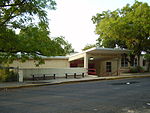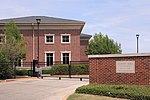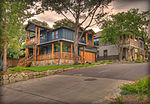Louis and Mathilde Reuter House
1934 establishments in TexasCity of Austin Historic LandmarksHouses completed in 1934Houses in Austin, TexasHouses on the National Register of Historic Places in Texas ... and 6 more
Mission Revival architecture in TexasNational Register of Historic Places in Austin, TexasRecorded Texas Historic LandmarksSpanish Colonial Revival architecture in TexasTexas Registered Historic Place stubsTexas building and structure stubs

The Louis and Mathilde Reuter House is a private limestone home in central Austin, Texas, United States, in the historic Travis Heights neighborhood. The home was built by Louis Reuter, a local entrepreneur who moved to Austin in 1918 and later opened the city's first self-service grocery store. The home boasts an unusual U-shaped design that combines Spanish Revival and Mission Revival styling, with Palladian windows. The home was built without a precise blueprint but rather a "footprint" on the property which spared the grandiose old oak trees. The home is located at 806 Rosedale Terrace. It was added to the National Register of Historic Places in 1987.
Excerpt from the Wikipedia article Louis and Mathilde Reuter House (License: CC BY-SA 3.0, Authors, Images).Louis and Mathilde Reuter House
Rosedale Terrace, Austin
Geographical coordinates (GPS) Address Nearby Places Show on map
Geographical coordinates (GPS)
| Latitude | Longitude |
|---|---|
| N 30.241111111111 ° | E -97.744444444444 ° |
Address
Rosedale Terrace 900
78704 Austin
Texas, United States
Open on Google Maps










